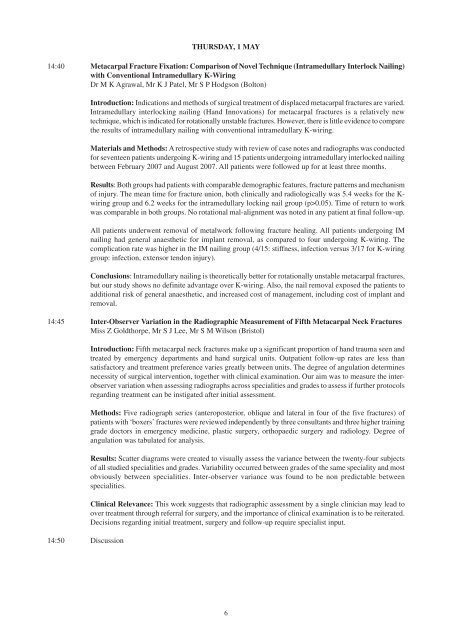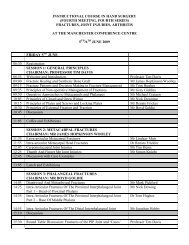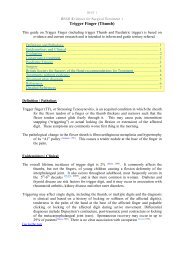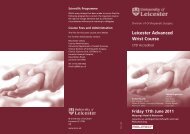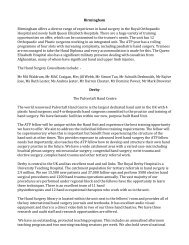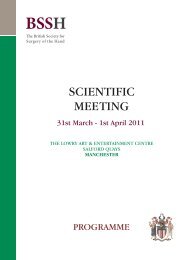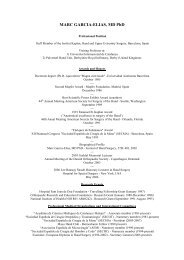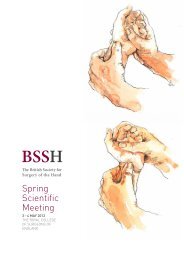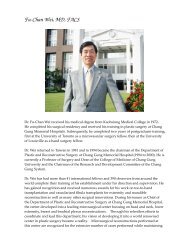here - The British Society for Surgery of the Hand
here - The British Society for Surgery of the Hand
here - The British Society for Surgery of the Hand
You also want an ePaper? Increase the reach of your titles
YUMPU automatically turns print PDFs into web optimized ePapers that Google loves.
14:40 Metacarpal Fracture Fixation: Comparison <strong>of</strong> Novel Technique (Intramedullary Interlock Nailing)<br />
with Conventional Intramedullary K-Wiring<br />
Dr M K Agrawal, Mr K J Patel, Mr S P Hodgson (Bolton)<br />
Introduction: Indications and methods <strong>of</strong> surgical treatment <strong>of</strong> displaced metacarpal fractures are varied.<br />
Intramedullary interlocking nailing (<strong>Hand</strong> Innovations) <strong>for</strong> metacarpal fractures is a relatively new<br />
technique, which is indicated <strong>for</strong> rotationally unstable fractures. However, t<strong>here</strong> is little evidence to compare<br />
<strong>the</strong> results <strong>of</strong> intramedullary nailing with conventional intramedullary K-wiring.<br />
Materials and Methods: A retrospective study with review <strong>of</strong> case notes and radiographs was conducted<br />
<strong>for</strong> seventeen patients undergoing K-wiring and 15 patients undergoing intramedullary interlocked nailing<br />
between February 2007 and August 2007. All patients were followed up <strong>for</strong> at least three months.<br />
Results: Both groups had patients with comparable demographic features, fracture patterns and mechanism<br />
<strong>of</strong> injury. <strong>The</strong> mean time <strong>for</strong> fracture union, both clinically and radiologically was 5.4 weeks <strong>for</strong> <strong>the</strong> K-<br />
wiring group and 6.2 weeks <strong>for</strong> <strong>the</strong> intramedullary locking nail group (p>0.05). Time <strong>of</strong> return to work<br />
was comparable in both groups. No rotational mal-alignment was noted in any patient at final follow-up.<br />
All patients underwent removal <strong>of</strong> metalwork following fracture healing. All patients undergoing IM<br />
nailing had general anaes<strong>the</strong>tic <strong>for</strong> implant removal, as compared to four undergoing K-wiring. <strong>The</strong><br />
complication rate was higher in <strong>the</strong> IM nailing group (4/15: stiffness, infection versus 3/17 <strong>for</strong> K-wiring<br />
group: infection, extensor tendon injury).<br />
Conclusions: Intramedullary nailing is <strong>the</strong>oretically better <strong>for</strong> rotationally unstable metacarpal fractures,<br />
but our study shows no definite advantage over K-wiring. Also, <strong>the</strong> nail removal exposed <strong>the</strong> patients to<br />
additional risk <strong>of</strong> general anaes<strong>the</strong>tic, and increased cost <strong>of</strong> management, including cost <strong>of</strong> implant and<br />
removal.<br />
14:45 Inter-Observer Variation in <strong>the</strong> Radiographic Measurement <strong>of</strong> Fifth Metacarpal Neck Fractures<br />
Miss Z Goldthorpe, Mr S J Lee, Mr S M Wilson (Bristol)<br />
14:50 Discussion<br />
THURSDAY, 1 MAY<br />
Introduction: Fifth metacarpal neck fractures make up a significant proportion <strong>of</strong> hand trauma seen and<br />
treated by emergency departments and hand surgical units. Outpatient follow-up rates are less than<br />
satisfactory and treatment preference varies greatly between units. <strong>The</strong> degree <strong>of</strong> angulation determines<br />
necessity <strong>of</strong> surgical intervention, toge<strong>the</strong>r with clinical examination. Our aim was to measure <strong>the</strong> interobserver<br />
variation when assessing radiographs across specialities and grades to assess if fur<strong>the</strong>r protocols<br />
regarding treatment can be instigated after initial assessment.<br />
Methods: Five radiograph series (anteroposterior, oblique and lateral in four <strong>of</strong> <strong>the</strong> five fractures) <strong>of</strong><br />
patients with ‘boxers’ fractures were reviewed independently by three consultants and three higher training<br />
grade doctors in emergency medicine, plastic surgery, orthopaedic surgery and radiology. Degree <strong>of</strong><br />
angulation was tabulated <strong>for</strong> analysis.<br />
Results: Scatter diagrams were created to visually assess <strong>the</strong> variance between <strong>the</strong> twenty-four subjects<br />
<strong>of</strong> all studied specialities and grades. Variability occurred between grades <strong>of</strong> <strong>the</strong> same speciality and most<br />
obviously between specialities. Inter-observer variance was found to be non predictable between<br />
specialities.<br />
Clinical Relevance: This work suggests that radiographic assessment by a single clinician may lead to<br />
over treatment through referral <strong>for</strong> surgery, and <strong>the</strong> importance <strong>of</strong> clinical examination is to be reiterated.<br />
Decisions regarding initial treatment, surgery and follow-up require specialist input.<br />
6


